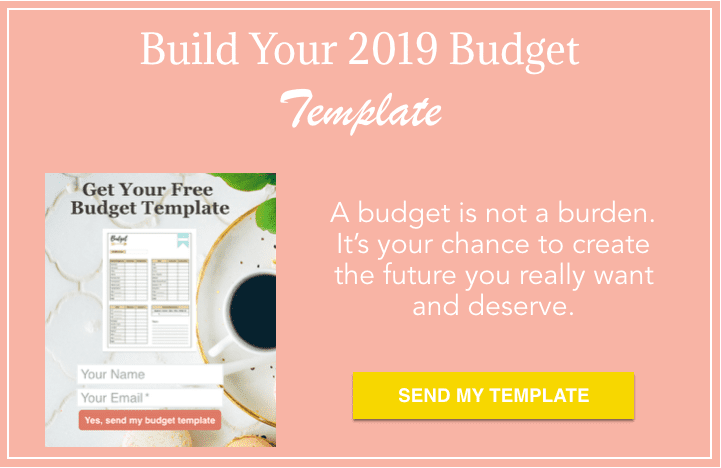How to Budget Better in 2021
(This article has been updated from 2019)
You look up to find it’s the end of another month… and a fresh new year!
You’ve been planning, setting goals, and getting excited about the momentum that the new year brings.
You even have a word like “Intentional” or “Focus” to help you keep it together.
If you’re anything like me, you love planning things out. But in the back of your mind you know it’s not enough.
You felt this same motivation and made these same lists last year but you still find yourself wondering where the heck all your hard earned money went. WTF
Today you are going to learn exactly how to tell your money what to do so that you can save more, invest more, and do more of all the things you love.
Plus, you can download the exact budget template that we use with our clients to save them hundreds of dollars every month.

Did you know that a budget is the cornerstone of your financial success?
Your budget is basically a blueprint that outlines how you want to allocate your money.
Could you imagine someone building a house without a blueprint? There would be utter chaos.
The builders wouldn’t know where to put anything, where to connect the electricity, or even what materials to buy. And to make it more personal, think about what your life would be like if you didn’t plan. It would be a mess!
Well guess what… that’s usually what you do to your money.
You go to work and put in our blood, sweat and tears but don’t make a plan for how to allocate your hard earned resources.
That’s crazy!
If you’re going to work so hard for your money, you should be making your money work just as hard (or harder) for you.
In fact, every single dollar is like a soldier in your financial army and it’s your job to give it a purpose.
Once you create a budget it becomes the cornerstone of your financial success. It’s certainly not the only thing you need to do, but it is the first point of action to breathe life into your finances.
Here are 4 steps everyone can take to create a better budget in 2019.
Step 1: Understand Your Top 3 Values
Being clear about what you value most is a great place to start.
This is your opportunity to dig deep and think about what really matters to you in your life on a financial level.
That might be financial security, travel, fun, investing, growth, charity, peace of mind, or any number of things.
Whatever it is, your values are there to help you prioritize how you allocate your money.
If it’s something you value, it should show up on your budget. If it’s not something you value then it should not dominate your budget.
Sounds like a common sense approach to spending money right?
The problem is, many haven’t openly embraced their values or they’re not honest about what those values are.
For example, if you value financial security then it would make sense for you to have an emergency fund that you contribute to on a regular basis.
If you value convenience, spending time with friends, or trying new foods, dining out might be a large expenditure as well.
Usually, people pretend that dining out is not high on the priority list, but when I look at the bank statements, it tells a different story.
This is what you need to know: Dining out is not the problem. Not being clear and upfront about it is.
When you’re honest about your priorities, you have more clarity about next steps.
Your money’s yours to do with as you please. But be sure to get clarity around your values and have them show up on your budget accordingly.
A simple, yet powerful directive.
Go ahead and write down your top 3 values for 2019
Step 2: Know Your Income Monthly
You would be surprised how many people don’t know how much money they bring home on a monthly basis.
Let’s be clear: If you don’t know how much money you have coming in every month, it’s impossible for you to successfully and productively allocate your financial resources.
If your monthly income is relatively steady, then your job is easy! Just look at your pay stub or your direct deposit.
But, if your income changes every month there are two options I usually recommend:
Take a look at your income from the past 3 months and come up with an average. Look at what you have coming up over the next 3 months and make an estimate based on what you see.
Set a realistic goal for your monthly income and do everything you can to reach it. If you fall short… don’t!! if you have a surplus, allocate it based on your goals and priorities.
Your income is the source of your personal financial ecosystem and the starting point of your financial breakthrough.
You should be clear about how much you make now and a plan for how to increase that number every 6 months.
Now, take a minute to write down your income on the budget template.
Step 3: Identify Your Monthly Spending
Step 3: Identify Your Monthly Spending
When it comes to outlining your monthly spending don’t try to do it from memory.
It’s not that I don’t trust you but… let’s verify with some receipts. Literally.
First, print out your bank statements from the past 3 months. Then, highlight your expenses, bills, and debts. Each with a different color.
Do yourself a favor and don’t be too hard on yourself about how much you’ve spent at Target… or Amazon. We all have our weaknesses.
Once you’ve highlighted your printout start looking at any patterns you notice.
Tally up how much you’ve spent per month in each budget category.
Finally, write down your spending in the categories provided on your budget template.
This might take some time so come back to it as we move along.
Step 4: Calculate What's Left
Once you’ve done steps 2 and 3, it’s time for the grand finale. Subtract the number from step 3 from the number in section 2.
Basically, income -expenses. This is what I like to call your uncommitted income.
Your uncommitted income should be how much money you have left after your bills, every day expenses, and debt payments.
At this point, you have not allocated any of your deposited paycheck to savings, investments, or anything else.
In theory, your uncommitted income should be a clear number that tells you how much money you have left to build with.
Building includes saving, investing, and paying down high interest rate credit card debt.
This is the money that is going into YOUR pocket and impacting your net worth.
For that reason, we have a whole separate system dedicated to planning that out.
To Conclude...
This is a very basic layout of a very intricate budgeting system that has one goal: to help you put more money in your bank accounts.
By breaking down the budget process into these 4 steps you can see each part of your financial equation clearly to pinpoint where you need the most work.
Are your values misaligned? Is your income too low? Is your spending too high? Do you have enough money to save and invest?
After you complete your budget you’ll feel confident about your ability to take control of your finances so that you can walk into the new year ready to work!
And as always, if you want a financial coach who can help you get real consistent results, be sure to reach out. In the mean time, feel free to download the template.











 It’s one thing to have a budget, but it’s another thing ENTIRELY to make it come to life.
It’s one thing to have a budget, but it’s another thing ENTIRELY to make it come to life.  For most people, that’s where the disconnect is. Not the budget itself.
For most people, that’s where the disconnect is. Not the budget itself.  Our Beyond the Budget Blueprint is specifically designed to help you fall in love with your budget and bring your goals to life.
Our Beyond the Budget Blueprint is specifically designed to help you fall in love with your budget and bring your goals to life.  $27, right now! Normally $197.
$27, right now! Normally $197.